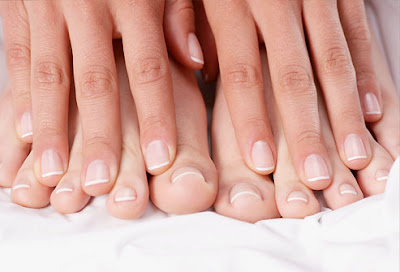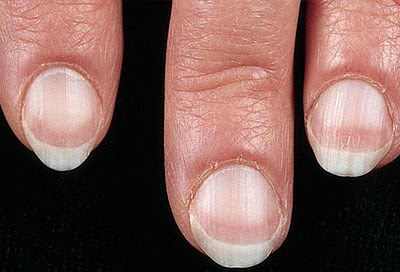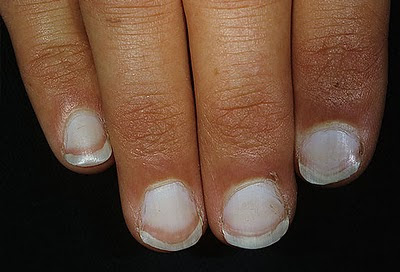
Nails and Health: Read the Signs
;Did you know your nails can reveal clues to your overall health?
kA touch of white here, a rosy tinge there, or some rippling or bumps may be a sign of disease in the body.
Problems in the liver, lungs, and heart can show up in your nails. .
But do you know how to read the signs?
Learn about some nail conditions that might require medical attention.
;Did you know your nails can reveal clues to your overall health?
kA touch of white here, a rosy tinge there, or some rippling or bumps may be a sign of disease in the body.
Problems in the liver, lungs, and heart can show up in your nails. .
But do you know how to read the signs?
Learn about some nail conditions that might require medical attention.
.If you have a nail problem that doesn't seem to be going away or is associated with other signs and symptoms, make an appointment with your doctor to get it checked out.
.
.
Keep reading to learn what secrets your nails might reveal.
_______________________________________
_______________________________________
Pale Nails
Very pale nails are sometimes linked to aging. But they can also be a sign of serious illness, such as:
Very pale nails are sometimes linked to aging. But they can also be a sign of serious illness, such as:
Anemia
Congestive heart failure
Diabetes
Liver disease
Malnutrition
Spoon nails
Spoon nails (koilonychia) are soft nails that look scooped out. The depression usually is large enough to hold a drop of liquid. Spoon nails may be a sign of iron deficiency anemia.
Spoon nails (koilonychia) are soft nails that look scooped out. The depression usually is large enough to hold a drop of liquid. Spoon nails may be a sign of iron deficiency anemia.
White Nails
If the nails are mostly white with darker rims, this can indicate liver problems, such as hepatitis.
In this image, you can see the fingers are also jaundiced, another sign of liver trouble.
In other cases, it can be a sign of serious illness, such as:
Congestive heart failure
Diabetes
Liver disease
Malnutrition
White Nails ( Terry's Nails)
The normal pinkish color of the nails turns completely white, with the disappearance of the half-moon circles at the base of the nails.
Clinical findings of liver diseases
White nails are commonly seen in patients with cirrhosis and rarely in other diseases. They are due to opacity of the nail bed. Nails appear white and a pinkzone is seen only at the tip of the nail. The lunula may be not distinguished.
Nail separates from nail bed
With a condition known as onycholysis, your fingernails become loose and can separate from the nail bed. If your nails show signs of detaching, this may be associated with:
Injury or infection
Thyroid disease
Drug reactions
Reactions to nail hardeners or acrylic nails
Psoriasis
Beau's lines
Beau's lines are indentations that run across your nails. They can appear when growth at the area under your cuticle is interrupted by injury or severe illness.
Beau's lines are indentations that run across your nails. They can appear when growth at the area under your cuticle is interrupted by injury or severe illness.
Diseases or illnesses associated with Beau's lines include:
Uncontrolled diabetes
Circulatory diseases, such as peripheral artery disease
Illness associated with a high fever, caused by pneumonia, scarlet fever, mumps or measles
Malnutrition
Clubbing
Clubbing occurs when the tips of your fingers enlarge and your nails curve around your fingertips. This condition results from low oxygen levels in your blood and could be a sign of lung disease.
Clubbing is also associated with inflammatory bowel disease, thyroid disease, cardiovascular disease and liver disease.
Yellow Nails
One of the most common causes of yellow nails is a fungal infection. As the infection worsens, the nail bed may retract, and nails may thicken and crumble. In rare cases, yellow nails can indicate a more serious condition such as severe thyroid disease or psoriasis.
Yellow nail syndrome
Yellow discoloration in your fingernails may result from a respiratory condition, such as chronic bronchitis, or from swelling of your hands (lymphedema). In yellow nail syndrome, nails thicken and new growth slows, resulting in discoloration. Nails affected with this condition may lack a cuticle and may detach from the nail bed in places. Although this condition is often a sign of respiratory disease, it's possible to have yellow nails and not have a respiratory condition. Yellow nails may also result from any condition that causes the growth of your nails to slow down.
Yellow discoloration in your fingernails may result from a respiratory condition, such as chronic bronchitis, or from swelling of your hands (lymphedema). In yellow nail syndrome, nails thicken and new growth slows, resulting in discoloration. Nails affected with this condition may lack a cuticle and may detach from the nail bed in places. Although this condition is often a sign of respiratory disease, it's possible to have yellow nails and not have a respiratory condition. Yellow nails may also result from any condition that causes the growth of your nails to slow down.
Bluish Nails
Nails with a bluish tint can mean the body isn’t getting enough oxygen. This could indicate an infection in the lungs, such as pneumonia.
Rippled Nails
If the nail surface is rippled or pitted, this may be an early sign of psoriasis or inflammatory arthritis. Psoriasis is a skin condition that starts in the nails 10% of the time.
Cracked or Split Nails
Dry, brittle nails that frequently crack or split have been linked to thyroid disease.
Dry, brittle nails that frequently crack or split have been linked to thyroid disease.
Cracking or splitting combined with a yellowish hue is more likely due to a fungal infection.
Puffy Nail Fold
If the skin around the nail appears red and puffy, this is known as inflammation of the nail fold. It may be the result of lupus or another connective tissue disorder.
Dark Lines Beneath the Nail
Dark lines beneath the nail should be investigated as soon as possible. They are sometimes caused by melanoma, the most dangerous type of skin cancer.
Dark lines beneath the nail should be investigated as soon as possible. They are sometimes caused by melanoma, the most dangerous type of skin cancer.
Gnawed Nails
Biting your nails may be nothing more than an old habit, but in some cases it’s a sign of persistent anxiety that could benefit from treatment. Nail biting or picking has also been linked to obsessive-compulsive disorder. If you can’t stop, it’s worth discussing with your doctor.
Nails Are Only Part of the Puzzle
Though nail changes accompany many conditions, these changes are rarely the first sign.
And many nail abnormalities are harmless not everyone with white nails has hepatitis. If you’re
concerned about the appearance of your nails, start by seeing your family doctor or a dermatologist.

What the nails know: Fingernails can provide early warning of health problems
Provided by:
The Canadian PressWritten
by: Helen Branswell, Medical Reporter
TORONTO - Fortune tellers say they can divine a person's destiny by reading the lines in the palm of the hand. But when it comes to discerning the state of one's health, turning the hand over is far more illuminating.
Fingernails can reveal an amazing amount about a person's health, medical experts say, with a surprising number of conditions manifesting themselves with changes in the shape, colour or overall state of the nails.
"It may be the first sign, it may be the herald sign of ... an internal disease," says Dr. Yves Poulin, a Quebec City dermatologist and president-elect of the Canadian Dermatology Association.
Lung disorders, nasal polyps, anemia, inflammatory bowel syndrome and liver diseases can provoke changes in the fingernails.
In some cases those alterations can prompt people to seek medical attention, in the process bringing to light previously undiagnosed conditions. In others, the state of a patient's nails will help a physician clarify what is at play.
"For us, it helps to make the correct diagnosis to look at the nail," Poulin says.The bed of the fingernails of healthy individuals should be a light pink. Nail beds that are white may suggest anemia - a red blood cell deficiency which itself can be a symptom of other, sometimes serious, diseases. When the nails themselves grow opaque and white, it can be a sign of liver disease.
White nails with a dark band at the tip - a condition called Terry's nails - can be a sign of aging but could also signal congestive heart failure, diabetes or liver disease.
Kidney problems are suspected with a condition known as half-and-half nail, in which the lower part of the nail bed is white but a portion towards the tip of the nail is pink.
Bluish nails can signal a lack of oxygen, a sign a person might be suffering from one of a number of lung conditions. Green nails can be caused by infection with Pseudomonas aeruginosa, a bacterium which is common in the environment. Antibiotics can clear up this condition.
Poulin says respiratory tract problems - such as nasal polyps and chronic sinusitis - can trigger yellow nail syndrome, which he describes as rare. It can be corrected in some cases, depending on the cause.
"I had a guy in recently, he was an attorney, he was 40 and he had yellow nails on all his nails.
And he had a nose surgery and it all went away," Poulin says.
Strangely shaped or marked nails are also indicative of a variety of conditions.Thickened, misshapen and cloudy nails - sometimes on the fingers, but more often on the toes - are generally a sign of infection with a fungus. Called onychomycosis, the condition is unsightly and makes the nails difficult to trim and maintain.
Onychomycosis can and should be treated, Poulin says, and the earlier the better.
The longer the problem festers, the harder it is to treat, he says.
And while thickened toe nails may be merely an esthetic problem for a 60-year-old, when that person is 80 and diabetic, toenails that can't be trimmed can trigger infections in the skin around the nail bed, erode foot health and threaten mobility.
"It may be an open door for cellulitis, for infections of the skin, in diabetic people," Poulin says. "(But) this is often neglected. People don't look too much at their toenails."
A brown or black streak or dot under a nail that persists can be skin cancer - melanoma, which can be deadly if it isn't caught early. And if there is no evident reason for the change in pigmentation, it should be checked out, says Dr. Mark Davis, a dermatologist at the Mayo Clinic's Rochester, Minn., campus.
"If patients can remember some trauma to their nail - that they actually have a reason for getting blood under their nail and it's usually painful - then it's nothing to be worried about," Davis says.
"But if somebody develops a new pigmentation on their nail, just like a new mole on your skin, it's best to have a dermatologist look at it and make the judgment as to whether it could be a melanoma or whether it's just a mole. And sometimes that can be quite difficult even for the dermatologist to decide."
Melanomas under the nail aren't common, but they do occur. But because people don't necessarily know of the possibility, such melanomas can go undetected, threatening chances of survival.
"People come very late with melanoma of the nail plate," says Poulin. "They have a black streak in the nail for years."
Someone who has horizontal groves across all their fingernails has experienced an illness that has interrupted the growth of the nails. The condition, called Beau's lines, is associated with uncontrolled diabetes, circulatory diseases or illnesses associated with high fever, the Mayo Clinic says.
While nail changes can signal something is going on with a person's health, sometimes the message they send isn't specific to a particular disease."For example, when you see clubbing of the nails, there's like 20 different things that can be associated with that," Davis says. He adds the warning, though, that "if that happens and it's new, it can be a sign of lung cancer."
The term clubbing is used to describe the swelling or enlarging of the tips of the fingers, with the nails curving downwards over the tip. While some people are born with clubbing, if it develops later on it can be a symptom of lung disease, congenital heart disorders, inflammatory bowel disease or liver problems.
Spoon nails, on the other hand, come about when the fingernails soften and curl inward from the sides, creating a concave surface. Also known as koilonychia, spoon nails can be a sign of iron-deficiency anemia.
Davis suggests paying attention to, but not fretting unduly, over changes to fingernails."If they notice a change in their nails, I think it's reasonable to check on it, but not to get overly alarmed about it.
Because there's lots of things that happen to the nails themselves that have nothing to do with any underlying conditions."
Nails make it easier to pick up small things, clean a frying pan, and scratch an itch. They also provide an external sign of your health, with weak, brittle nails often signaling some nutritional deficiency. Ignore your nails and you could wind up with painful ingrown nails or annoying fungal infections.
Follow these 14 tips for not only well-groomed, but healthy nails on all 20 fingers and toes.
1. To keep your nails hydrated, rub a small amount of petroleum jelly into your cuticle and the skin surrounding your nails every evening before you go to bed or whenever your nails feel dry. Keep a jar in your purse, desk drawer, car — anywhere you might need it. Not a fan of petroleum jelly? Substitute castor oil. It’s thick and contains vitamin E, which is great for your cuticles. Or head to your kitchen cupboard and grab the olive oil — it also works to moisturize your nails.
2. Wear rubber gloves whenever you do housework or wash dishes. Most household chores, from gardening to scrubbing the bathroom to washing dishes, are murderous on your nails. To protect your digits from dirt and harsh cleaners, cover them with vinyl gloves whenever it’s chore time. And for extra hand softness, apply hand cream before you put on the rubber gloves.
3. When pushing back your cuticles (it is not necessary to cut them) come in at a 45-degree angle and be very gentle. Otherwise the cuticle will become damaged, weakening the entire nail, says Mariana Diaconescu, manicurist at the Pierre Michel Salon in New York City.
4. Trim your toenails straight across to avoid ingrown toenails. This is particularly important if you have diabetes.
5. Dry your hands for at least two minutes after doing the dishes, taking a bath/shower, etc. Also dry your toes thoroughly after swimming or showering. Leaving them damp increases your risk of fungal infection.
6. Air out your work boots and athletic shoes. Better yet, keep two pairs and switch between them so you’re never putting your feet into damp, sweaty shoes, which could lead to fungal infections.
7. Wear 100 percent cotton socks. They’re best for absorbing dampness, thus preventing fungal infections.
8. Stretch out the beauty of a manicure by applying a fresh top coat every day, says Susie Galvez, owner of Face Works Day Spa in Richmond, Virginia, and author of Hello Beautiful: 365 Ways to Be Even More Beautiful.
9. Make your nails as strong as a horse’s hooves, and take 300 micrograms of the B vitamin biotin four to six times a day. Long ago, veterinarians discovered that biotin strengthened horses’ hooves, which are made from keratin, the same substance in human nails. Swiss researchers found that people who took 2.5 milligrams of biotin a day for 5.5 months had firmer, harder nails. In a U.S. study, 63 percent of people taking biotin for brittle nails experienced an improvement.
10. Add a glass of milk and a hard-boiled egg to your daily diet. Rich in zinc, they’ll do wonders for your nails, especially if your nails are spotted with white, a sign of low zinc intake.
11. File your nails correctly. To keep your nails at their strongest, avoid filing in a back-and-forth motion — only go in one direction. And never file just after you’ve gotten out of a shower or bath — wet nails break more easily.
12. Massage your nails to keep them extra strong and shiny. Nails buffing increases blood supply to the nail, which stimulates the matrix of the nail to grow, says Galvez.
13. Polish your nails, even if it’s just with a clear coat. It protects your nails, says manicurist Diaconescu. If you prefer color, use a base coat, two thin coats of color, and a top coat. Color should last at least seven days but should be removed after 10 days.
14. Avoid polish removers with acetone or formaldehyde. They’re terribly drying to nails, says Andrea Lynn Cambio, M.D., a New York City dermatologist. Use acetate-based removers instead.
_____________
Other Health and Wellness Articles
,














No comments:
Post a Comment